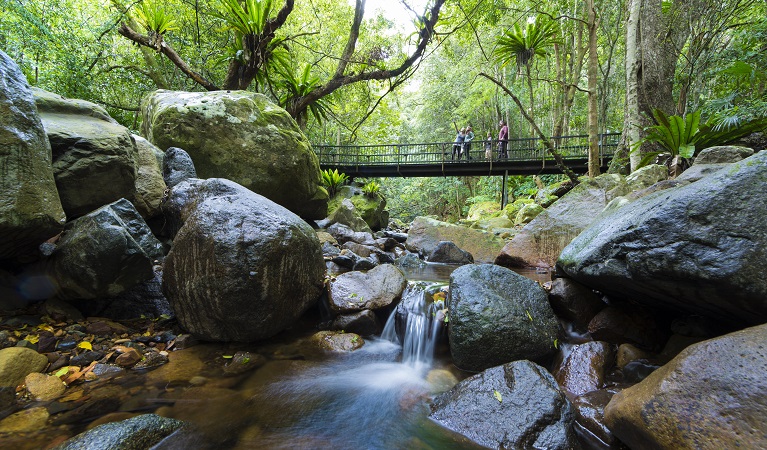School excursion
The Minnamurra Rainforest ecosystem
Budderoo National Park
Overview
The Minnamurra Rainforest ecosystem is a school excursion at Minnamurra Rainforest for Stage 6, Year 12 students undertaking a case study of a functioning ecosystem for the Ecosystem and global biodiversity focus area.
Read more about The Minnamurra Rainforest ecosystem
Students undertake fieldwork that includes an examination of natural and human impacts at this location, and the management of this environment.
They collect information on the biophysical environment through the completion of data collection and measurements. Students examine sustainable management practices in place, and propose potential management of issues.
For program outline, safety and practical information about this excursion, see info for teachers
| Stage | Stage 6 (Years 11-12) |
|---|---|
| Learning area | Geography |
| Student outcomes |
GE-12-01. Analyses rural and urban places, ecosystems, global biodiversity and economic activity, for their characteristics, spatial patterns, interactions, and nature and extent of change over time GE-12-02. Analyses geographical processes and influences, at a range of scales, that form and transform places and environments GE-12-03. Assesses geographical opportunities and challenges, and the role of varying perspectives and responses in their management GE-12-04. Evaluates responses and management strategies, at a range of scales, for sustainability GE-12-07. Selects and applies geographical inquiry skills and tools, including spatial technologies, fieldwork and ethical practices, to investigate places and environments |
| Objectives |
Students will:
|
Excursion details
- Availability
- Guided. Available on request. Different length programs are available upon consultation.
- Duration
- 2-5 hr
- Grading
- Easy. Fieldwork will take place along a river beside the rainforest path.
- Price
-
Minimum $550 per group for up to 25 students, $22 per student (includes GST).
- Accessibility
- No wheelchair access
- Meeting point
- Minnamurra Rainforest Centre
- Equipment
provided - Yes. Worksheet masters, pre and post-activity resources, and additional references will be provided on booking.
- Booking
- If you would like to organise a NPWS school excursion please get in touch with local staff or use the 'Enquire' link for the online form.
Local alerts
For the latest updates on fires, closures and other alerts in this area, see https://www.nationalparks.nsw.gov.au/education/stage-6-geography-the-minnamurra-rainforest-ecosystem-budderoo-national-park/local-alerts
Operated by
- School excursion inquiries - Minnamurra Rainforest Centre
- 02 4236 0469
- discovery.scr@environment.nsw.gov.au
- Budderoo National Park, Minnamurra Falls Road (Tourist Drive No.9), via Jamberoo NSW 2533
Park info
- in Budderoo National Park in the South Coast and Country NSW regions
Budderoo National Park is always open but may have to close at times due to poor weather or fire danger. The park gates at Minnamurra Rainforest Centre open at 9am and close at 5pm every day.
-
Park entry fees:
$12 per vehicle per day only in the Minnamurra Rainforest area. Bus or taxi: $4.40 per adult and $2.20 per child.
Buy annual pass.
Info for teachers
All the practical information you need to know about The Minnamurra Rainforest ecosystem.
Program outline
- Welcome, acknowledgement of Country and safety briefing
- Morning tea and toilet break
- Classroom presentation
- Fieldwork collection
- Complete a vegetation transect
- Soil and leaf litter survey
- Group discussion and question time
- Guided interpretive walk through rainforest
- Optional self-guided walk to waterfall (teacher to lead)
- Lunch
- Farewell and depart on bus
Getting there and parking
Minnamurra Rainforest Centre is located in the foothills of Jamberoo Valley, west of Kiama on the NSW South Coast. To get there from Jamberoo, drive west on Jamberoo Road and turn left onto Jamberoo Mountain Road. Take the first right onto Minnamurra Falls Road, and you’ll find Minnamurra Rainforest Centre about 3km along to the end of the road.
Road quality
- Sealed roads
Vehicle access
- 2WD vehicles
Weather restrictions
- All weather
Parking
Car and bus parking is available in a bitumen carpark at Minnamurra Rainforest Centre, including 2 accessible parking spots.
Note that coach bookings are essential prior to arrival.
What to bring
Students should wear enclosed shoes, layered clothing (including a raincoat if wet weather is likely) and a hat, and bring a refillable water bottle. Students should have their own copy of the excursion worksheet, a clipboard and pencil.
Maps and downloads
Risk assessment and risk benefits
Our rangers and guides have the technical skill and experience to assess the risks and the benefits of a variety of activities delivered as part of our learning programs.
We believe in including opportunities that allow students to learn and experience for themselves through exploration in the natural environment.
Please make your own risk assessment based on the information provided. Detailed potential risks and controls are provided for the site to assist teachers in risk management planning. Teachers and carers should be aware of, and consider the needs, abilities and medical conditions of students when visiting this site. The supervision of students remains the responsibility of the teacher. The school must ensure an adequate number of adult supervisors are present.
Accessibility
Disability access level - no wheelchair access
Not wheelchair-accessible

